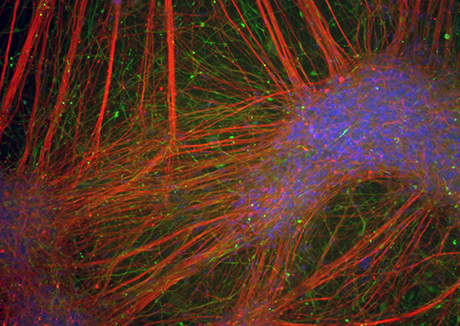New substance selectively blocks Alzheimer’s enzyme

UZH Researchers have shown that it is possible to inhibit the Alzheimer’s disease process specifically without affecting the physiological processes using induced pluripotent stem cell-derived neurons. (Image: UZH)
For decades, intensive research has been conducted on drugs all over the world to treat Alzheimer’s patients. Although major progress has been made in diagnostics (the disease can be detected increasingly early and accurately), the therapeutic options remain limited.
Together with researchers in Switzerland, Germany and India, the team headed by Professor Lawrence Rajendran from the Systems and Cell Biology of Neurodegeneration at the Institute of Regenerative Medicine of the University of Zurich has now developed a targeted substance that blocks the pathogenic function of an enzyme in the cells without affecting its other vital functions.
Protein deposits in the brain are hallmarks of Alzheimer’s disease and partly responsible for the chronically progressive necrosis of the brain cells. Nowadays, these plaques can be detected at very early stages, long before the first symptoms of dementia appear. The protein clumps mainly consist of the β amyloid peptide (Aβ), a protein fragment that forms when two enzymes, β and γ secretase, cleave the amyloid precursor protein (APP) into three parts, including Aβ, which is toxic.
Blocking the harmful process without affecting any useful functions
If β or γ secretase is blocked, this also inhibits the production of any more harmful β amyloid peptide. Consequently, for many years biomedical research has concentrated on these two enzymes as therapeutic points of attack. To date, however, the results of clinical studies using substances that block γ secretase have been sobering. The problem is that the enzyme is also involved in other key cell processes. Inhibiting the enzymes in patients therefore triggered severe side effects, such as gastrointestinal hemorrhaging or skin cancer.
Thus, for a number of years researchers have also been focusing their efforts on β secretase. A large number of substances have been developed, including some highly promising ones that reduced the amount of Aβ in mouse models effectively. Nevertheless, according to cell biologist Rajendran, this presents the same challenge: “The current β secretase inhibitors don’t just block the enzyme function that drives the course of Alzheimer’s, but also physiologically important cell processes. Therefore, the substances currently being tested in clinical studies may also trigger nasty side effects – and thus fail.”
Promising substance to be studied on Alzheimer’s patients
To address this, the first author on the publication, Saoussen Ben Halima in the lab of Professor Rajendran, and her fellow researchers studied how β secretase might be inhibited selectively – in other words, the harmful property blocked without affecting any useful functions. In a series of experiments, the scientists were able to demonstrate that the Alzheimer’s protein APP is cleft by β secretase in endosomes, special areas of the cells that are separated by membrane envelopes, while the other vital proteins are processed in other areas of the cell. The researchers exploited this spatial separation of the protein processing within the cell.
“We managed to develop a substance that only inhibits β secretase in the endosomes where the β amyloid peptide forms. The specific efficacy of our inhibitor opens up a promising way to treat Alzheimer’s effectively in future, without causing the patients any serious side effects,” says Rajendran in summary. The researchers’ next goal is to hone their drug candidate so that it can initially be tested in mice and ultimately in clinical studies on Alzheimer’s patients.
Literature:
Saoussen Ben Halima, Sabyashachi Mishra, K. Muruga Poopathi Raja, Michael Willem, Antonio Baici, Kai Simons, Oliver Brüstle, Philipp Koch, Christian Haass, Amedeo Caflisch, and Lawrence Rajendran. Specific Inhibition of β-Secretase Processing of the Alzheimer’s Disease Amyloid Precursor Protein. Cell Reports. February 25, 2016. doi: 10.1016/j.celrep.2016.01.076
Alzheimer’s and dementia in figures
Around eight percent of over-65s and more than 30 percent of people who are younger than 90 suffer from Alzheimer’s or another form of dementia. According to the Swiss Alzheimer’s Association, around 120,000 people living in this country currently suffer from dementia – a figure that is set to rise to 200,000 patients by 2030 on account of demographic developments. Dementia is already the most common reason for needing care in old age in Switzerland and the third most common cause of death after cardiovascular disease and cancer.
Contact:
Prof. Lawrence Rajendran
Institute of Regenerative Medicine
Psychiatric University Hospital
University of Zurich
Phone: +41 44 634 88 60
E-mail: rajendran@bli.uzh.ch
http://www.mediadesk.uzh.ch/articles/2016/neuer-wirkstoff-blockiert-alzheimer-enzym-gezielt_en.html
Media Contact
More Information:
http://www.uzh.ch/All latest news from the category: Life Sciences and Chemistry
Articles and reports from the Life Sciences and chemistry area deal with applied and basic research into modern biology, chemistry and human medicine.
Valuable information can be found on a range of life sciences fields including bacteriology, biochemistry, bionics, bioinformatics, biophysics, biotechnology, genetics, geobotany, human biology, marine biology, microbiology, molecular biology, cellular biology, zoology, bioinorganic chemistry, microchemistry and environmental chemistry.
Newest articles

NASA: Mystery of life’s handedness deepens
The mystery of why life uses molecules with specific orientations has deepened with a NASA-funded discovery that RNA — a key molecule thought to have potentially held the instructions for…

What are the effects of historic lithium mining on water quality?
Study reveals low levels of common contaminants but high levels of other elements in waters associated with an abandoned lithium mine. Lithium ore and mining waste from a historic lithium…

Quantum-inspired design boosts efficiency of heat-to-electricity conversion
Rice engineers take unconventional route to improving thermophotovoltaic systems. Researchers at Rice University have found a new way to improve a key element of thermophotovoltaic (TPV) systems, which convert heat…



